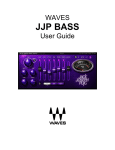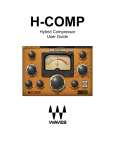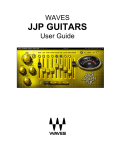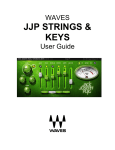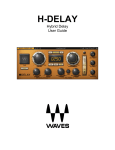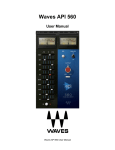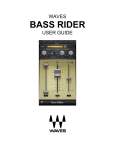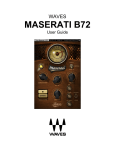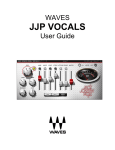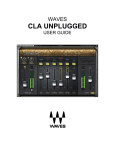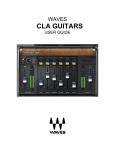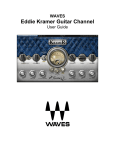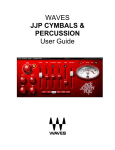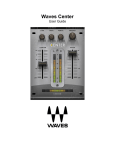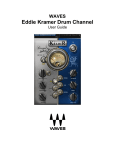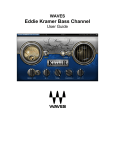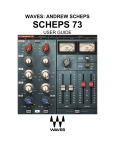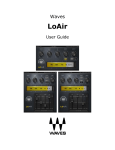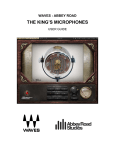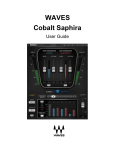Download W43 Noise Reduction User Manual
Transcript
WAVES W43 NOISE REDUCTION PLUGIN TABLE OF CONTENTS CHAPTER 1 – INTRODUCTION ...................................................................................... 3 1.1 WELCOME ................................................................................................................. 3 1.2 PRODUCT OVERVIEW................................................................................................. 3 1.3 COMPONENTS ........................................................................................................... 4 CHAPTER 2 – QUICK START GUIDE............................................................................. 5 CHAPTER 3 – INTERFACE AND CONTROLS ............................................................... 6 3.1 INTERFACE ................................................................................................................ 6 3.2 CONTROLS ................................................................................................................ 7 CHAPTER 4 – THE WAVESYSTEM ................................................................................ 9 4.1 THE WAVESYSTEM TOOLBAR..................................................................................... 9 4.2 PRESET HANDLING .................................................................................................... 9 4.3 INTERFACE CONTROLS ............................................................................................ 12 4.4 WAVES PREFERENCES (PRO TOOLS ONLY) .............................................................. 13 W43 Noise Reduction Plugin User Guide 2 Chapter 1 – Introduction 1.1 Welcome Thank you for choosing Waves! In order to get the most out of your Waves processor, please take the time to read through this manual. In conjunction, we also suggest that you become familiar with www.wavesupport.net. There you will find an extensive Answer Base, the latest Tech Specs, detailed Installation guides, new Software Updates, and current information on Authorization and Registration. By signing up at www.wavesupport.net, you will receive personalized information on your registered products, reminders when updates are available, and information on your authorization status. 1.2 Product Overview Inspired by the legendary CAT43, the W43 noise reduction plugin builds upon the legacy of the rare unit that’s been a post production favorite for decades. W43 delivers high quality, minimal artifact multiband noise reduction like the original hardware, while adding all the advantages of software. Like the original, the W43 was designed to suppress noise from hiss, hum, traffic, wind, air conditioning and other ambient sources, and provides control over four individual frequency bands. About Waves Post Production Tools When Waves decided to develop a line of dedicated audio processors especially for Post Production, we conferred with the people who truly understand the field better than anyone: The Post professionals who design, edit, and mix sound for motion pictures, television, multimedia, and video games. Waves knows that Post Production work presents audio engineers with specialized challenges. Once we had identified and analyzed these issues and concerns, we set out to provide the highest quality Post Production sound solutions available. Waves is proud to bring more than two decades of audio processing expertise to the world of Post Production. W43 Noise Reduction Plugin User Guide 3 1.3 Components WaveShell technology enables us to split Waves processors into smaller plug-ins, which we call components. Having a choice of components for a particular processor gives you the flexibility to choose the configuration best suited to your material. The W43 consists of two components: W43 Mono W43 Stereo W43 Noise Reduction Plugin User Guide 4 Chapter 2 – Quick Start Guide Insert the W43 on a dialog track. Typically, it should be placed before other dynamic processors which may increase noise. Starting with all four bands and the Threshold control at the "0" (zero) position, gradually lower the slider representing the most likely frequency range, until sufficient noise reduction is achieved. Please note: Even when all four frequency bands are at the "0" (zero) position, processing is taking place (when the Engage control is on). A “True Flat” preset, in which input and output signal most resemble one another, is available in the factory presets. Additional useful and typical settings can be found under the load menu. W43 Noise Reduction Plugin User Guide 5 Chapter 3 – Interface and Controls 3.1 Interface W43 Noise Reduction Plugin User Guide 6 3.2 Controls THRESHOLD determines the level at which noise reduction begins across the four bands. Range: +3 to -3 (0 is calibrated to -39 dBFS) RANGE FADERS determine the amount of noise reduction applied to each band. Range: +2 to -4 dB • Low: 30 Hz – 80 Hz • Low Mid: 80 Hz – 1 kHz • High Mid: 1 kHz – 3 kHz • High: 3 kHz – 20 kHz W43 Noise Reduction Plugin User Guide 7 ENGAGE enables and disables the noise reduction process. Please note that the plugin, like the hardware unit that inspired it, affects the audio signal even when the noise reduction process is not engaged (disabled). In order to achieve true bypass, please use the host bypass. W43 Noise Reduction Plugin User Guide 8 Chapter 4 – The WaveSystem 4.1 The WaveSystem Toolbar All Waves processors feature the WaveSystem toolbar which takes care of most administrative functions you will encounter while working with your Waves software. The features of the WaveSystem toolbar are the same on practically all Waves processors, so familiarity with its features will be helpful whichever processor you are using. Toolbar Functions Undo Redo Setup A/B Copy A->B Load Save ? Undoes the last 32 actions. Redoes the last 32 undone actions. Toggles between two presets. This is useful for close comparison of different parameter settings Copies the current settings to the second preset register Recalls presets from file Saves presets in the Waves file formats Opens the manual for the processor you are using 4.2 Preset Handling Preset Types Factory Presets are permanent presets in the Load menu. Factory presets cannot be over-written or deleted. When applicable, different component plug-ins may have different factory presets. User Presets are your favorite settings of the plug-in saved as a preset in the Load menu, under ‘User Presets’. User Presets can be over-written and deleted. Setup Files may contain more than one preset. For example, a single file can contain all the presets for a session. When you open a Setup File, all its setups become part of your Load pop-up menu for fast access. This can be particularly useful with multiple instances of a plug-in in a single session. By saving all the settings you create into a single Setup File, they can all be quickly available for every instance of that plug-in. W43 Noise Reduction Plugin User Guide 9 Loading Presets and Setups Click on the Load button to see the Load pop-up menu. The menu is divided into four sections. If a section is not currently available it will not appear in the Load pop-up menu. Open Preset File… Select to open any setup or preset file, whether from the Library or your own creations. ‘Filename.xps’: Displays any currently loaded Setup File and its presets. Displays the default Factory Presets. Factory Presets: User Presets: Displays any loaded User Presets. Saving Presets and Setups Click on the Save button to see the Save pop-up menu. Four options are available. If an option is not currently available it will be grayed out and inaccessible. Select this to start a new Setup file. There are two prompts - first for the setup filename, then for the preset name. You must provide a name for both the setup file and the preset. Click OK (ENTER) to complete the save. It is a good idea to create a folder in which to save several setup files for a project. Save ‘File Name’ – “Preset Name” Overwrites the settings of the loaded preset (whether a User Preset or a preset from a Setup File) with the current settings. If a Setup File is currently loaded, the name of the Setup File is displayed followed by the name of the preset itself. If a User Preset is loaded, its name is displayed. Save to ‘File Name’ As… Saves the current settings as a new preset into the Setup file that is open (if one is not open, the option is grayed out). You will be prompted to give the preset a name. Put into Preset Menu As… Save the current settings into a User Preset that will always be in your Load menu (until deleted). You will be prompted to give this preset a name. User Presets are stored in the plug-in’s preference file. Save to New File… W43 Noise Reduction Plugin User Guide 10 Deleting Presets You may delete User Presets and presets within a Setup File. Factory Presets and Setup Library files cannot be deleted or overwritten. 1. Hold the Command (Mac)/Control (PC) key down. 2. Click-and-hold the Load button to see the pop-up menu. 3. While still holding the Command/Control key, select the preset or setup to delete. 4. A confirmation box will appear, allowing you to cancel or ‘OK’ the deletion. A/B Comparison and Copying The Setup A/Setup B button may be clicked to compare two settings. If you load a preset in the Setup B position, this will not affect the preset loaded into the Setup A position, and vice-versa. If you want to slightly modify the settings in Setup A, you can copy them to Setup B by clicking on the Copy to B button, then alter Setup A and compare with the original Setup B. The name of the current setup will be shown in the title bar (on platforms which support it), and will switch as you change from Setup A to Setup B. Note: an asterisk will be added to the preset name when a change is made to the preset. W43 Noise Reduction Plugin User Guide 11 4.3 Interface Controls Controls can be in one of three states: • • • Not Selected where the control is not the target of any user entry Selected where the control is the target of mouse control entry only Selected and Active where the control is the target for both mouse and keyboard entry Toggle Buttons Toggle buttons display the state of a control, and allow switching between two or more states. Single-click to change the control’s state. Some toggle buttons have a text display which updates with the current setting, and others (bypass, solo, or monitoring toggles) illuminate when the control is active. Some processors have link buttons between a pair of toggle buttons, allowing clickand-drag adjustment while retaining the offset between the controls. Value Window Buttons Value windows display the value of a control and allow click-and-drag adjustment, or direct control via the keyboard. • • • Using the mouse, click-and-drag on the value window to adjust. Some value windows support left/right, some up/down (as you hover over a button, arrows will appear to let you know which direction of movement that button supports). Using the arrow keys, click once with mouse to select the button, and then use up/down – left/right (depending on the direction supported by that button) to move in the smallest incremental steps across the button’s range (holding down the arrow keys will move faster through the range). Using key entry, double click on the button to open the value window, and directly enter the value from your keyboard. If you enter an out of range number, the button stays selected but remains at the current setting (system beeps? If system sounds are on?) Some processors have link buttons between a pair of value windows, allowing clickand-drag adjustment while retaining the offset between the controls. Sliders Click on the slider itself or anywhere within the sliders track. The numerical value of the slider settings is displayed in a hover window above the slider path. W43 Noise Reduction Plugin User Guide 12 Hover Box Hovering boxes will appear and display the control value when hovering with the mouse over the control. TAB Functions TAB moves the ‘selected’ status to the next control, with shift-TAB moving in the reverse direction. Additionally, the Mac has an option-TAB function for ‘down’ movement and shift-optionTAB for ‘up’ movement where applicable. If you have several Value Window Buttons selected, TAB functions will take you through the selected controls only. Hitting Esc or Return will return the 'focus' to the DAW application. 4.4 Waves Preferences (Pro Tools only) When launching Pro Tools, hold Shift to view the Waves plug-in Preferences window. The following options are available: • • • • • • Don't use AudioSuite plug-ins Dont use RTAS plug-ins Don't use TDM plug-ins Rescan all plug-ins HUI control surfaces support (low res) Enable single-click text entry W43 Noise Reduction Plugin User Guide 13













